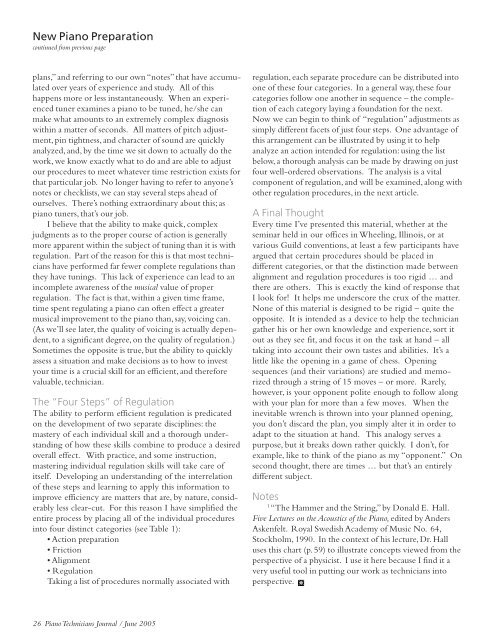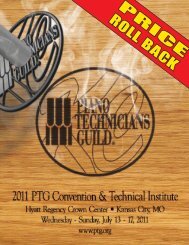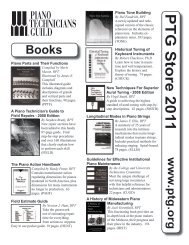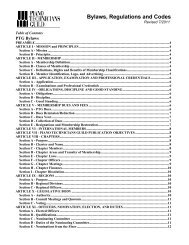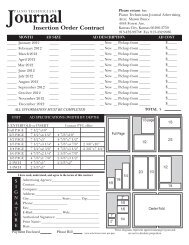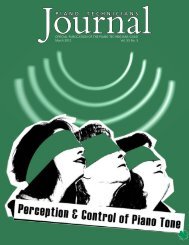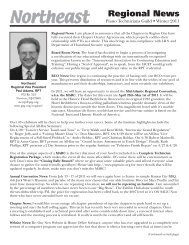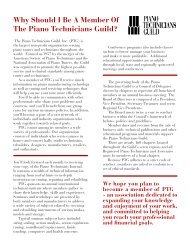Download PDF - Piano Technicians Guild
Download PDF - Piano Technicians Guild
Download PDF - Piano Technicians Guild
You also want an ePaper? Increase the reach of your titles
YUMPU automatically turns print PDFs into web optimized ePapers that Google loves.
New <strong>Piano</strong> Preparation<br />
continued from previous page<br />
plans,” and referring to our own “notes” that have accumulated<br />
over years of experience and study. All of this<br />
happens more or less instantaneously. When an experienced<br />
tuner examines a piano to be tuned, he/she can<br />
make what amounts to an extremely complex diagnosis<br />
within a matter of seconds. All matters of pitch adjustment,<br />
pin tightness, and character of sound are quickly<br />
analyzed, and, by the time we sit down to actually do the<br />
work, we know exactly what to do and are able to adjust<br />
our procedures to meet whatever time restriction exists for<br />
that particular job. No longer having to refer to anyone’s<br />
notes or checklists, we can stay several steps ahead of<br />
ourselves. There’s nothing extraordinary about this; as<br />
piano tuners, that’s our job.<br />
I believe that the ability to make quick, complex<br />
judgments as to the proper course of action is generally<br />
more apparent within the subject of tuning than it is with<br />
regulation. Part of the reason for this is that most technicians<br />
have performed far fewer complete regulations than<br />
they have tunings. This lack of experience can lead to an<br />
incomplete awareness of the musical value of proper<br />
regulation. The fact is that, within a given time frame,<br />
time spent regulating a piano can often effect a greater<br />
musical improvement to the piano than, say, voicing can.<br />
(As we’ll see later, the quality of voicing is actually dependent,<br />
to a significant degree, on the quality of regulation.)<br />
Sometimes the opposite is true, but the ability to quickly<br />
assess a situation and make decisions as to how to invest<br />
your time is a crucial skill for an efficient, and therefore<br />
valuable, technician.<br />
The “Four Steps” of Regulation<br />
The ability to perform efficient regulation is predicated<br />
on the development of two separate disciplines: the<br />
mastery of each individual skill and a thorough understanding<br />
of how these skills combine to produce a desired<br />
overall effect. With practice, and some instruction,<br />
mastering individual regulation skills will take care of<br />
itself. Developing an understanding of the interrelation<br />
of these steps and learning to apply this information to<br />
improve efficiency are matters that are, by nature, considerably<br />
less clear-cut. For this reason I have simplified the<br />
entire process by placing all of the individual procedures<br />
into four distinct categories (see Table 1):<br />
• Action preparation<br />
• Friction<br />
• Alignment<br />
• Regulation<br />
Taking a list of procedures normally associated with<br />
regulation, each separate procedure can be distributed into<br />
one of these four categories. In a general way, these four<br />
categories follow one another in sequence – the completion<br />
of each category laying a foundation for the next.<br />
Now we can begin to think of “regulation” adjustments as<br />
simply different facets of just four steps. One advantage of<br />
this arrangement can be illustrated by using it to help<br />
analyze an action intended for regulation: using the list<br />
below, a thorough analysis can be made by drawing on just<br />
four well-ordered observations. The analysis is a vital<br />
component of regulation, and will be examined, along with<br />
other regulation procedures, in the next article.<br />
A Final Thought<br />
Every time I’ve presented this material, whether at the<br />
seminar held in our offices in Wheeling, Illinois, or at<br />
various <strong>Guild</strong> conventions, at least a few participants have<br />
argued that certain procedures should be placed in<br />
different categories, or that the distinction made between<br />
alignment and regulation procedures is too rigid … and<br />
there are others. This is exactly the kind of response that<br />
I look for! It helps me underscore the crux of the matter.<br />
None of this material is designed to be rigid – quite the<br />
opposite. It is intended as a device to help the technician<br />
gather his or her own knowledge and experience, sort it<br />
out as they see fit, and focus it on the task at hand – all<br />
taking into account their own tastes and abilities. It’s a<br />
little like the opening in a game of chess. Opening<br />
sequences (and their variations) are studied and memorized<br />
through a string of 15 moves – or more. Rarely,<br />
however, is your opponent polite enough to follow along<br />
with your plan for more than a few moves. When the<br />
inevitable wrench is thrown into your planned opening,<br />
you don’t discard the plan, you simply alter it in order to<br />
adapt to the situation at hand. This analogy serves a<br />
purpose, but it breaks down rather quickly. I don’t, for<br />
example, like to think of the piano as my “opponent.” On<br />
second thought, there are times … but that’s an entirely<br />
different subject.<br />
Notes<br />
1<br />
“The Hammer and the String,” by Donald E. Hall.<br />
Five Lectures on the Acoustics of the <strong>Piano</strong>, edited by Anders<br />
Askenfelt. Royal Swedish Academy of Music No. 64,<br />
Stockholm, 1990. In the context of his lecture, Dr. Hall<br />
uses this chart (p. 59) to illustrate concepts viewed from the<br />
perspective of a physicist. I use it here because I find it a<br />
very useful tool in putting our work as technicians into<br />
perspective.<br />
26 <strong>Piano</strong> <strong>Technicians</strong> Journal / June 2005


